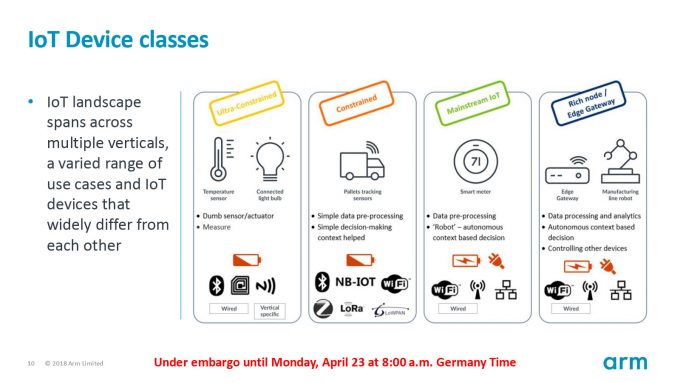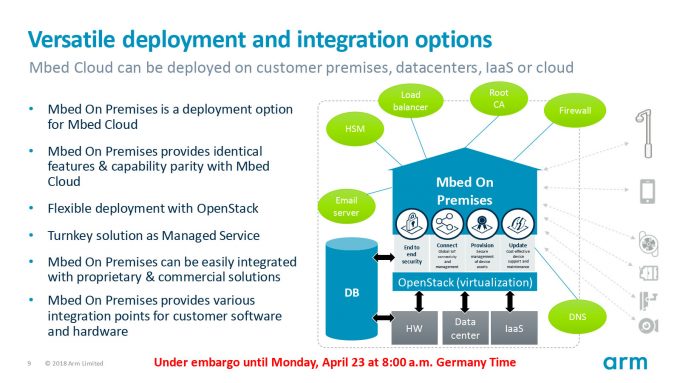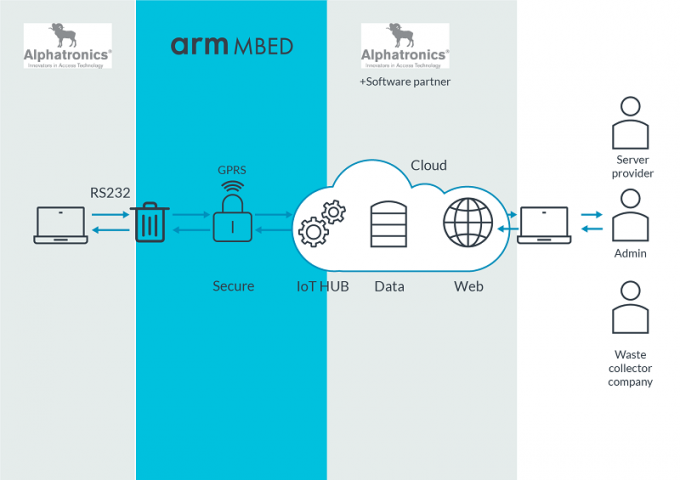- Qualcomm Launches Snapdragon 4 Gen 2 Mobile Platform
- AMD Launches Ryzen PRO 7000 Series Mobile & Desktop Platform
- Intel Launches Sleek Single-Slot Arc Pro A60 Workstation Graphics Card
- NVIDIA Announces Latest Ada Lovelace Additions: GeForce RTX 4060 Ti & RTX 4060
- Maxon Redshift With AMD Radeon GPU Rendering Support Now Available
Arm Announces New Partners With Its Mbed IoT Platform

Sometimes it’s nice to see the other side of what goes into consumer electronics. We often see the faults of IoT, but rarely how it’s used in the industry. Arm briefed us on what the industry in general is doing with IoT, as well as some of its partners, case studies, and what’s being done to reverse the security stigma.
Hannover Messe in Germany is a trade show for industry, and it’s where Arm outlined some of what it’s doing with its IoT plan, releasing details on partnerships with Cybertrust and GlobalSign, Alphatronics, and IBM Watson. This all centers around Arm’s Mbed platform, the OS and software layer that is used as a device management system for IoT enabled devices.
Internet of Things, or IoT, is a term that embodies mixed feelings to many people. While there are many possibilities to the technology, it often brings up feelings of dread when you see the frequent security exploits around home ‘security’ systems and the inane lifestyle products such as Internet connected toasters, kettles, and washing machines.
While there are many products that make you question the validity of the technology, there are many more examples of where IoT can make a difference, and it’s usually the stuff you don’t even see or know about. Consumer electronics get a lot of the bad reputation, but it’s industry and businesses that can see the most benefits.
We’ve been mentioning Arm a lot over the last few months. It’s a company that’s responsible for the biggest tech explosion in the last two decades; the designer of the core architecture that sits in nearly every single smartphone central processor on the market. Since being picked up by SoftBank, Arm is on a mission to enable ‘a world of a trillion connected devices’, and part of that plan involves IoT.
While many consumer IoT electronics have been on the market for years, the various fitness trackers being one of the early adopters, it was often big companies with large R&D budgets that could put the effort into making such devices. Now it’s becoming a case of buying ready to go off-the-shelf SoC, putting your own software on top and rolling out a new product. Now Arm is pushing for custom SoC designs and ASICs that anyone can develop with its DesignStart program, and it’s not just consumer electronics that can make use of it. Limited runs of 1000 units for oil and mining sensor boards for internal purposes, without worrying about licensing and royalties, can all be managed and updated with Mbed.
IoT in industry and enterprise doesn’t just have to mean connected to the Internet, it can also means connected to any network. It’s a way of bringing some form of smart functionality to a wide variety of small devices, and Arm was keen to highlight some of the examples and business case studies that are putting the technology to use.
Barcodes and RFID are one of the cheapest ways to micromanage various systems, as they can all be linked back to a central database, but sometimes you need extra data, and a way to process that data. Sometimes it can be simple things like adding temperature probes and access records to warehouse pallets, sometimes it can be more complex like checking how often a bin is used so that refuse collection only happens when it’s needed, and not based on a fixed schedule. Arm was quick to point out a number of other interesting use cases, such as PV cell monitoring in solar farms, to tracking growth and performance of individual trees for farming.
It’s these smaller tasks, either out in the field or in a huge factory/warehouse, where IoT can start to show some significant potential, not just in automation, but also planning. The number of applications it can be used with is quite staggering, and it’s hard not to get caught up in the huge buzzword driven marketing that typically comes with such potential, which is why it’s important to focus on the real benefits that are happening now.
IoT’s shady past with security from the consumer electronics side of things, does overshadow much of the enthusiasm with the technology, which is why the whole ‘security first’ approach is something that Arm has been working with extensively the last year. The first sign was with Arm’s Platform Security Architecture (PSA) which includes certificate authentication, unique device IDs, secure-boot, and OTA updates. There is also Kigen and iSIM, embedding SIM cards into the SoC, allowing devices to always be connected to the Internet, but at the same time to remain secure with certificates and remote provisioning.
It’s these certificate needs that prompted Arm to partner up with GlobalSign and Cybertrust, which allows for 3rd party certs to be issued and either loaded into the IoT device at time of manufacture, or loaded with the Mbed Cloud Bootstrap capabilities. Internal, self-signed certs can also be used, along with the PSA capabilities and Mbed TLS.
When dealing with a few devices, management is relatively simple. As more devices are added and need to be managed, Mbed Cloud can automate many of the tasks, such as updates and data gathering. When things get more complex and ‘big data’ is needed, then analytics becomes a priority. This is when Arm partnered up with IBM and its Watson IoT platform. This lets companies roll out updates, automate security, as well as work as a translation layer between different protocols.
And Cloud doesn’t have to mean ‘someone elses computer’ in this case, as Mbed Cloud can be setup on local premises, no third parties involved.
Arm also showcased a very interesting case study, something alluded to previously with a waste management system. Alphatronics was contacted by a French company to help deploy a system to manage waste collection in very remote facilities. These sites didn’t have easy access to power nor wired connectivity, so battery and solar-powered devices with some form of wireless connectivity was required.
The company was wasting resources on collection of refuse from sites that were effectively empty due to long periods of low usage. Scheduling fewer pickups was one option but there would also be bouts of large collections as well; a better system was needed. Alphatronics was contacted due to previous work in Belgium, and developed a new IoT based system that was ultra low power with remote monitoring of the refuse, so that instead of scheduled collections, an on-demand pickup service could be rolled out. The sites also needed to be secured so that only local users could use the site.
Arm is still working with a number of other partners, as well as case studies on how its Mbed platform can be used. IoT still has a long way to go before it overcomes the stigma around security, but with continued efforts and a ‘security first’ mentality, that can be overcome in time. When it comes to the practical application of the technology, you don’t have to think Internet connected vacuum cleaners anymore, as industry is already putting it to use in farming, waste management, transport, and just about everything responsible for building the products you use on a daily basis.
Support our efforts! With ad revenue at an all-time low for written websites, we're relying more than ever on reader support to help us continue putting so much effort into this type of content. You can support us by becoming a Patron, or by using our Amazon shopping affiliate links listed through our articles. Thanks for your support!








